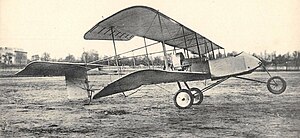The Voisin L was a pusher biplane developed for the French Army's 1912 trials[1] where it performed successfully. About 70 were built in France[2] with around 400 manufactured under license in the Russian Empire.[3] The aircraft was the first in a series of military pusher biplanes from Voisin all of which had similar design characteristics.[1] During the early stages of World War I the aircraft were primarily used for reconnaissance.
| Voisin L | |
|---|---|

| |
| Role | Reconnaissance, Bomber, Trainer |
| Manufacturer | Voisin Anatra Dux |
| Designer | Gabriel Voisin |
| First flight | 1912 |
| Primary users | Aéronautique Militaire Aéronavale Imperial Russian Air Service |
| Number built | 70 (France) 400 (Russian Empire) |
| Developed into | Voisin III |
The Voisin L was the only rotary engine powered aircraft designed by Gabriel Voisin. The official French military designation for aircraft powered by the Rhône 9C was the Voisin I while those fitted with the Gnome Monosoupape 7A were designated as the Voisin II. The rotary engine on the Voisin L drove a large two bladed wooden propeller via a reduction gearbox.[4]
Design
editThe Voisin L had equal-span wings with no dihedral. A cruciform tail was attached to the wings with booms. A streamlined nacelle carried a pilot and observer in front with a single rotary engine at the rear.[1] Steel tubing was used throughout the structure making the Voisin-L a robust aircraft for its time-period.[5]
Land-based versions of the aircraft featured a distinctive quadricycle landing gear. A floatplane version was produced with the quadricycle landing gear replaced with three flat bottomed pontoons.[1]
Voisin-Ls can be identified as they are the only model fitted with air-cooled rotary engines and so lacked the bulky radiators seen on later Voisin pushers which were powered by water-cooled Salmson 9, Peugeot 8Aa and Renault 12Fe aero-engines.[6]
Operational history
editAt the start of World War I, Voisin L aircraft (types 1 and 2) were in service with four French squadrons. The aircraft were used for artillery observation and as daylight bombers.[5] Voisin-Ls were in front line service till 1915 when the French airforce was reorganized with production focused on a smaller number of dedicated types. One of the types selected for mass production was the Voisin III.[7]
In the Russian Empire, Voisin L aircraft were manufactured by Anatra in Odesa[8] and the Duk Factory in Moscow. Both manufacturers also license built Voisin III aircraft.[3][8] Voisin L aircraft remained in front line with the Imperial Russian Air Service into 1916.[9]
Variants
edit- Type 1, Voisin I or Voisin-Rhône - Fitted with the Rhône 9C[1][6][4]
- Type 2, Voisin II or Voisin-Gnome - Fitted with a Gnome rotary engine.[1][6][4] Early examples were fitted with the Gnome Omega. Later examples used the seven-cylinder variant of the Gnome Monosoupape.[4]
Type 1 and 2 are designations applied retrospectively.[6] Contemporary names for the aircraft included the Voisin model 1912[1] and Voisin 13.5 meter.[10] In all cases Voisin L was the aircraft's factory designation.[1][4]
Operators
editSpecifications (Type 1)
editData from Renato[6]
General characteristics
- Crew: 2 (pilot and observer)
- Length: 10.5 m (34 ft 5 in)
- Wingspan: 13.5 m (44 ft 3 in)
- Height: 2.9 m (9 ft 6 in)
- Wing area: 42 m2 (450 sq ft)
- Empty weight: 825 kg (1,819 lb)
- Gross weight: 1,100 kg (2,425 lb)
- Powerplant: 1 × Le Rhône 9C rotary engine, 60 kW (80 hp)
- Propellers: 2-bladed fixed-pitch pusher propeller driven at ~600 rpm (half the engine speed) via a gearbox[4]
Performance
- Maximum speed: 95 km/h (59 mph, 51 kn)
- Time to altitude: 1,000 m (3,281 ft) in 11 minutes[11]
Armament
- Bombs: Up to 59 kg (130 lb) carried inside the nacelle and dropped over the side by the observer[12]
See also
editAircraft of comparable role, configuration, and era
Related lists
References
edit- ^ a b c d e f g h Simons, Graham M (2019). "Hydro avions". Early French Aviation (1905-1930). Pen and Sword. ISBN 9781526758750.
- ^ Davilla, James J; Soltan, Arthur M (2002). French aircraft of the First World War. Flying Machines Press. p. 542. ISBN 9781891268090.
- ^ a b Blume, August G (2010). The Russian Military Air Fleet in World War I. Vol. 1 - A chronology 1910-1917. United States: Schiffer. pp. 297–298. ISBN 978-0764333514.
- ^ a b c d e f Pernet, Andre (January 1963). "La Premier Victorie Aerienne" [The first air victory]. Aviation (in French) (362): 46–47.
- ^ a b Ulanoff, Stanley M (1970). "Bomber and Reconnaissance Aircraft". Illustrated history of World War I in the air. United States: Arco Publishing. p. 135. ISBN 9780668017688.
- ^ a b c d e Pinto, Renato (1981). "Voisin L". Perfiles Historia De La Aviacion [History of aviation] (in Spanish). Vol. 1. Spain: Viscontea. pp. 65–72.
- ^ Sumner, Ian (2015). The Kings of the Air: French Aces and Airmen of the Great War. Pen and Sword. p. 41. ISBN 9781783463381.
- ^ a b Robinson, Antony (1979). "Wings for the Tzar". The Illustrated Encyclopedia of Aviation. Vol. 1. United Kingdom: Marschal Cavendish. p. 57. ISBN 085685574X.
- ^ Kulikov, Victor (2013). "Aces of the 9th AOI". Russian Aces of World War 1. United Kingdom: Osprey Publishing Limited. ISBN 9781780960609.
- ^ Opdycke, Leonard E (1999). French Aeroplanes before the Great War. United States: Schiffer Military History. p. 271. ISBN 0764307525.
- ^ "Naval and Military Aeronautics". The Aeroplane. United Kingdom. 22 January 1914. p. 86.
- ^ Taylor, John W. R. (1969). Combat aircraft of the world: from 1909 to the present. United Kingdom: Putnam. p. 131. LCCN 68-25459.